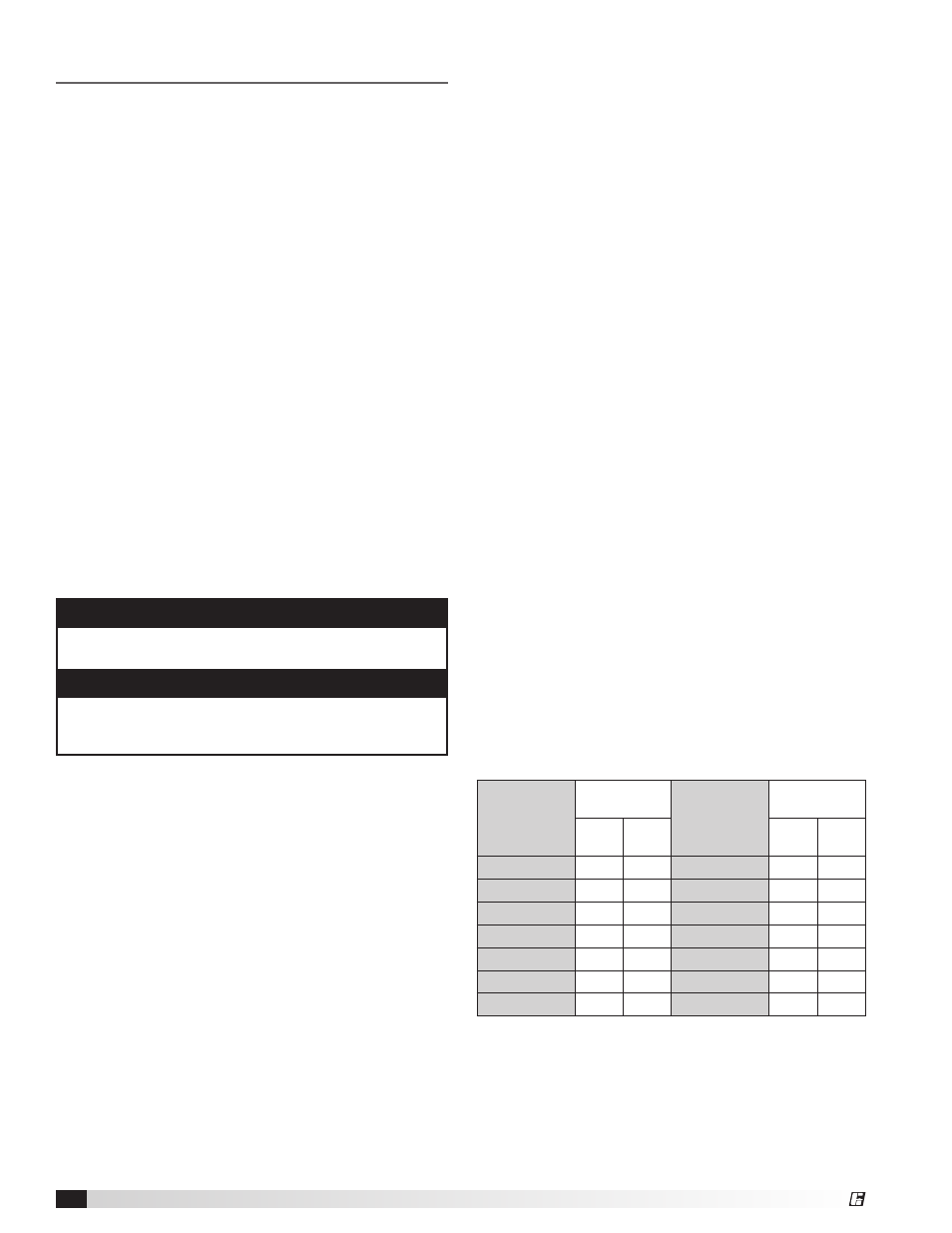Maintenance - fall, Winterizing chilled water coils, Blowing-out coils – Greenheck DG/DGX Pilot Ignition (470651_IOM) User Manual
Page 36: Flushing coils, Start-up, High limit, Burner, Gas train, Evaporative coolers

Percent of
Ethylene
Glycol
by Volume
Freeze Point
Percent of
Propylene
Glycol
by Volume
Freeze Point
ºF
ºC
ºF
ºC
0
32
0
0
32
0
10
25
-4
10
26
-3
20
16
-9
20
19
-7
30
3
-16
30
8
-13
40
-13
-25
40
-7
-22
50
-34
-37
50
-28
-33
60
-55
-48
60
-60
-51
Winterizing Chilled Water Coils
During the winter, chilled water coils need to be
protected against freezing. Manufacturer recommends
protecting the coils by either blowing-out the coils or
by flushing the coils.
Blowing-Out Coils
1. Close valves on the supply and return lines.
2. Open drain valves and/or drain plug. Remove vent
plug to allow coil to drain faster.
3. After coil is fully drained, connect a blower to the
caps. Do not connect the blower to the air vent or
drain plug.
4. Close the vent plug on the header that the blower
is connected to. Open the drain valve or cap on
the other header.
5. Turn on blower for 30 minutes. Place mirror at
discharge. If the mirror fogs up, repeat procedure
until no fog appears on the mirror.
6. After drying the coil, wait a few minutes then
repeat Step #5.
7. Leave drains open and do not install plugs until
beginning of cooling season.
Flushing Coils
Manufacturer recommends the use of inhibited glycol
(such as propylene or ethylene) to flush water coils
to protect against freezing. Additionally, the use of
inhibited glycol provides corrosion protection.
The table below indicates the percentage of glycol
required to prevent freezing in a coil at a given
outdoor air freeze point. Completely fill coil with
solution. Drain coil. Residual glycol fluid per these
concentrations can be left in the coil without concern
of freezing. Recovered fluid can be used to flush other
coils.
Maintenance - Fall
Start-Up
Repeat the Blower Start-Up Step #5 and Direct Gas
Start-Up Steps #1, #2 and #3. This will ensure that the
gas and air are set properly before the heating season
begins and should lead to trouble free operation all
winter.
High Limit
The high limit switch may have tripped over the
summer; it should be checked and reset if necessary.
Burner
Inspect the burner for accumulation of scales on both
the upstream and downstream sides of the mixing
plates. Any scaling or foreign material should be
removed with a wire brush.
Visually check that all holes in the mixing plates are
clear. If any burner ports are plugged (even partially),
clear them with a piece of wire or another appropriate
tool.
Replace or tighten any loose or missing fasteners on
the mixing plates. Always use zinc plated or stainless
steel fasteners.
Inspect and clean the flame and spark rod. Occasional
replacement of the flame rod and spark rod may be
necessary to ensure optimum unit performance.
Gas Train
The gas connections, joints and valves should be
checked annually for tightness. Apply a soap and
water solution or other approved leak test solution to
all piping; watch for bubbling which indicates a leak.
Other leak testing methods can be used.
Evaporative Coolers
The water should be shut off and all the lines drained
when the outside temperature drops below 45ºF.
Remove drain plugs for the winter.
Clean all interior parts of any mineral deposits or
foreign materials that may have built-up during the
cooling season.
Replace any worn or non-functioning parts.
WARNING
Do not enlarge burner ports when clearing a
blockage, performance could be affected.
NOTE
Flame rods can last many years, but because of
thermal expansion of the porcelain, flame rods can
fail over time.
Model DG / DGX Pilot Ignition Make-Up Air
36
®
